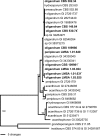Influence of Pythium oligandrum biocontrol on fungal and oomycete population dynamics in the rhizosphere
- PMID: 19447961
- PMCID: PMC2708430
- DOI: 10.1128/AEM.02643-08
Influence of Pythium oligandrum biocontrol on fungal and oomycete population dynamics in the rhizosphere
Abstract
Fungal and oomycete populations and their dynamics were investigated following the introduction of the biocontrol agent Pythium oligandrum into the rhizosphere of tomato plants grown in soilless culture. Three strains of P. oligandrum were selected on the basis of their ability to form oospores (resting structures) and to produce tryptamine (an auxin-like compound) and oligandrin (a glycoprotein elicitor). Real-time PCR and plate counting demonstrated the persistence of large amounts of the antagonistic oomycete in the rhizosphere throughout the cropping season (April to September). Inter-simple-sequence-repeat analysis of the P. oligandrum strains collected from root samples at the end of the cropping season showed that among the three strains used for inoculation, the one producing the smallest amount of oospores was detected at 90%. Single-strand conformational polymorphism analysis revealed increases in the number of members and the complexity of the fungal community over time. There were no significant differences between the microbial ecosystems inoculated with P. oligandrum and those that were not treated, except for a reduction of Pythium dissotocum (ubiquitous tomato root minor pathogen) populations in inoculated systems during the last 3 months of culture. These findings raise interesting issues concerning the use of P. oligandrum strains producing elicitor and auxin molecules for plant protection and the development of biocontrol.
Figures






Similar articles
-
Rhizosphere persistence of three Pythium oligandrum strains in tomato soilless culture assessed by DNA macroarray and real-time PCR.FEMS Microbiol Ecol. 2007 Aug;61(2):317-26. doi: 10.1111/j.1574-6941.2007.00348.x. Epub 2007 Jun 11. FEMS Microbiol Ecol. 2007. PMID: 17627780
-
Colonization of Pythium oligandrum in the tomato rhizosphere for biological control of bacterial wilt disease analyzed by real-time PCR and confocal laser-scanning microscopy.Phytopathology. 2008 Feb;98(2):187-95. doi: 10.1094/PHYTO-98-2-0187. Phytopathology. 2008. PMID: 18943195
-
Influence of Pythium oligandrum on the bacterial communities that colonize the nutrient solutions and the rhizosphere of tomato plants.Can J Microbiol. 2012 Sep;58(9):1124-34. doi: 10.1139/w2012-092. Epub 2012 Aug 22. Can J Microbiol. 2012. PMID: 22913267
-
Biological control of plant pathogens: advantages and limitations seen through the case study of Pythium oligandrum.Environ Sci Pollut Res Int. 2014 Apr;21(7):4847-60. doi: 10.1007/s11356-013-1807-6. Epub 2013 May 22. Environ Sci Pollut Res Int. 2014. PMID: 23695856 Review.
-
Pythium oligandrum in plant protection and growth promotion: Secretion of hydrolytic enzymes, elicitors and tryptamine as auxin precursor.Microbiol Res. 2022 May;258:126976. doi: 10.1016/j.micres.2022.126976. Epub 2022 Feb 8. Microbiol Res. 2022. PMID: 35158298 Review.
Cited by
-
The mycoparasite Pythium oligandrum induces legume pathogen resistance and shapes rhizosphere microbiota without impacting mutualistic interactions.Front Plant Sci. 2023 Oct 20;14:1156733. doi: 10.3389/fpls.2023.1156733. eCollection 2023. Front Plant Sci. 2023. PMID: 37929182 Free PMC article.
-
The Hydroponic Rockwool Root Microbiome: Under Control or Underutilised?Microorganisms. 2023 Mar 24;11(4):835. doi: 10.3390/microorganisms11040835. Microorganisms. 2023. PMID: 37110258 Free PMC article. Review.
-
Transformation of the endochitinase gene Chi67-1 in Clonostachys rosea 67-1 increases its biocontrol activity against Sclerotinia sclerotiorum.AMB Express. 2017 Dec;7(1):1. doi: 10.1186/s13568-016-0313-x. Epub 2017 Jan 3. AMB Express. 2017. PMID: 28050842 Free PMC article.
-
Myco-Suppression Analysis of Soybean (Glycine max) Damping-Off Caused by Pythium aphanidermatum.Plants (Basel). 2021 Apr 16;10(4):788. doi: 10.3390/plants10040788. Plants (Basel). 2021. PMID: 33923755 Free PMC article.
-
Eco-smart biocontrol strategies utilizing potent microbes for sustainable management of phytopathogenic diseases.Biotechnol Rep (Amst). 2024 Sep 10;44:e00859. doi: 10.1016/j.btre.2024.e00859. eCollection 2024 Dec. Biotechnol Rep (Amst). 2024. PMID: 39308938 Free PMC article. Review.
References
-
- Allain-Boulé, N., R. Tweddell, M. Mazzola, R. Bélanger, and C. A. Lévesque. 2004. Pythium attrantheridium sp. nov.: taxonomy and comparison with related species. Mycol. Res. 108:795-805. - PubMed
-
- Benhamou, N., P. Rey, M. Chérif, J. Hockenhull, and Y. Tirilly. 1997. Treatment with the mycoparasite Pythium oligandrum triggers induction of defense-related reactions in tomato roots when challenged with Fusarium oxysporum f. sp. radicis-lycopersici. Phytopathology 87:108-122. - PubMed
-
- Benhamou, N., P. Rey, K. Picard, and Y. Tirilly. 1999. Ultrastructural and cytochemical aspects of the interaction between the mycoparasite Pythium oligandrum and soilborne plant pathogens. Phytopathology 89:506-517. - PubMed
-
- Benhamou, N., R. R. Bélanger, P. Rey, and Y. Tirilly. 2001. Oligandrin, the elicitin-like protein produced by the mycoparasite Pythium oligandrum, induces systemic resistance to Fusarium crown and root rot in tomato plants. Plant Physiol. Biochem. 39:681-698.
-
- Bonnet, P., E. Bourdon, M. Ponchet, J. P. Blein, and P. Ricci. 1996. Acquired resistance triggered by elicitins in tobacco and other plants. Eur. J. Plant Pathol. 102:181-192.
Publication types
MeSH terms
LinkOut - more resources
Full Text Sources
Other Literature Sources
Medical
Miscellaneous

